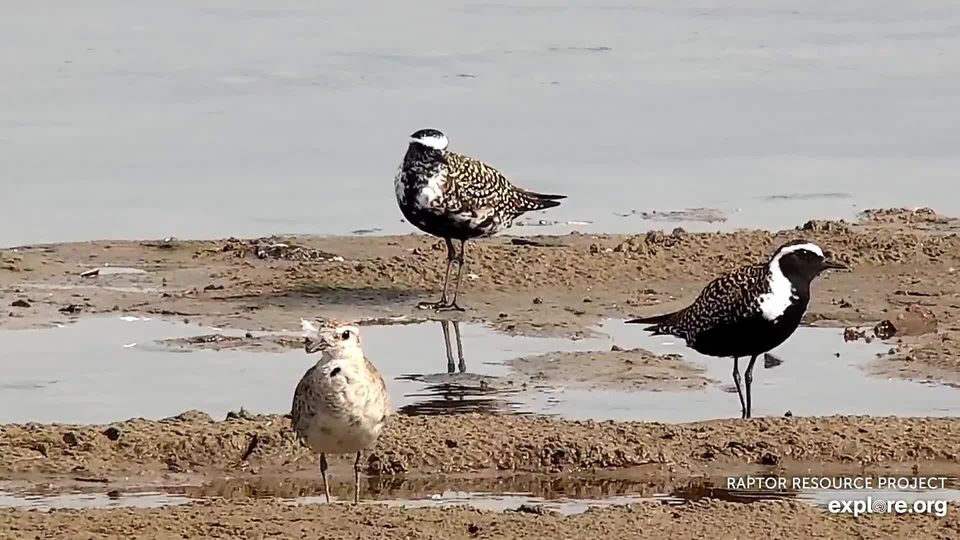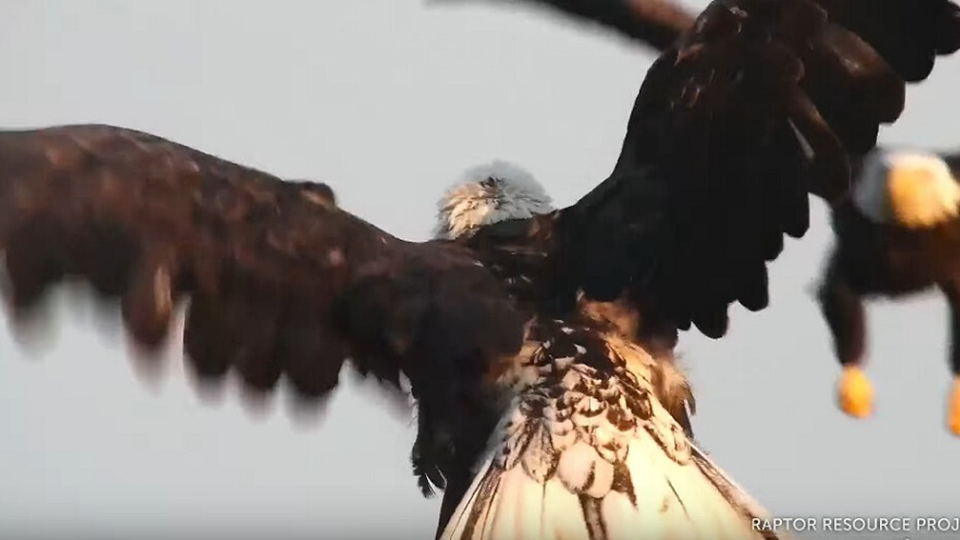Sandhill Crane: Paleolithic Dancer
Food: Omnivore | Finds Food By: Probing | Habitat: Marshes, Islands, and Fields

Sandhill Cranes nesting in the north migrate long distances, while those in the south migrate shorter distances or remain year-round. This is sometimes referred to as a leapfrog migration, since northern cranes ‘leap’ over southern cranes on their journey south. The cranes we see from September through October are a mix of locals, short-distance migrants, and cranes from the far north.
Security is challenging to a sandhill crane. Because they do not swim, they are unable to use deep water like geese, ducks, and swans do; nor can they stay on land, where mammalian predators will find them. The northwestern side of Lake Onalaska, with its abundance of open shallow water and shifting sandbars, provides the perfect place for sandhill cranes to nest, gather, and prepare for migration in safety. During migration and winter, family units group together with other families and nonbreeders: roosting, feeding, competing, dancing, displaying, and lancing my heart with their incredible vocalizations.
Sandhill cranes are all over the sandbar. Adults and children stay close, while unmated cranes gather in large groups to forage, explore, display, and – is that the crane equivalent of flirting? The moon rises as the sun sets, and a resonant bugle splits the air. Suddenly all of the cranes are calling. In a few weeks, they will leave for open water and agricultural fields further south. But for now, they are safe and sound on their little patch of Mississippi River paradise.
American Golden Plover: Little but Mighty!
Food: Aquatic Invertebrates | Finds Food By: Probing | Habitat: Grasslands

No other group of birds illustrates the dependence of migrants on small, widely spaced islands of habitat as vividly as shorebirds. Many of them fly thousands of miles between pit stops. When they stop, they must be able to refuel quickly and efficiently before resuming their flight, which makes the places that support them important beyond measure.
The American Golden Plover nests on sparse, rocky ground in the high arctic: picture four buffy eggs marked with splotches of dark brown and nestled in scrapes among sedges, grass, and lichens. Plover parents do not feed their young, although they lead them to foraging areas and protect them from predators. After young fledge at 22-23 days of age, the family separates to join large foraging and migratory flocks.
This early independence is good, since juveniles and adults migrate separately. Tundra, forest, farmland, large cities, the Mississippi River, the Gulf of Mexico, and the savannahs of South America roll beneath their wings as they make one of the world’s longest migrations, traveling 8,000 miles or more from the high Arctic to the grasslands of Argentina and Uruguay. These small but mighty birds stop on the muddy sandbars of Lake Onalaska to tank up on the worms, snails, small crustaceans, and insects that power their trip.
Why are we seeing American Golden Plovers in October? We think that they usually migrate from western Canada and Alaska east to New England and south along the Atlantic seaboard, returning to their breeding grounds via the Mississippi flyway in the spring. But these little birds are easy to overlook and not much is known about their journey through the interior. Fall or spring, I’m thrilled to see them!
An American golden plover forages in the shallow waters of Lake Onalaska. Damming the Mississippi drowned migratory habitat deep under water. But new human-made islands harnessed the river’s tireless engine to restore lost habitat, including the sandbars, mudflats, floodplain forests, and braided channels that hold the food it needs to fuel its epic journey. Once the plover has eaten its fill, it will take to the sky, rested and ready for the next 1000-mile leg of its migration.
Trumpeter Swan: The World’s Largest Waterfowl
Food: Plants | Finds Food By: Dabbling | Habitat: Lakes, Ponds, and Rivers
Trumpeter swans migrate with their young for one complete fall and spring migration cycle. Adults introduce youngsters to specific routes, stopover sites, and wintering grounds, which they memorize along the way. Young who survive and mate successfully will introduce their own children to these same routes, passing migratory traditions down to the next generation. Are swans staging in the same places and migrating along the same routes they once did? We don’t know. The old migratory traditions were lost when the swan population dwindled to just 69 individuals in the contiguous United States in 1935. It’s good to see them here now.
Breeding Trumpeter Swans prefer relatively shallow, undisturbed bodies of freshwater with abundant aquatic plants. They need at least 100 yards of open water for their running take-offs, and muskrat or beaver dens or small islands on which to nest. Parents work together to build nests, incubate eggs, and care for young, who fledge between 84 to 122 days of age. While swans from Canada and Alaska fly south to find ice-free water, swans in the Midwest often remain year-round or make short flights to water kept open by dams, power plants, and natural features. The swans we see in October and November are a mix of locals and short-to-medium-distance migrants that are stopping to rest and feed. They might winter in open water just south of La Crosse, or continue on to Missouri, Nebraska, or southern Indiana.
A small group of swans floats just off the sandbar, loosely mingling with a larger flock of tundra swans. The shallow waters of Lake Onalaska provide the food and habitat that this family needs to create new migratory traditions. With enough habitat and support, those traditions will be passed down through tens of thousands of generations. Long may they fly!
Bald Eagle: Welcome to Eagle College!
Food: Other Animals (Living and Dead) | Finds Food By: Soaring and Hunting | Habitat: Near Food

How many eagles can you count? How about 30 eagles squabbling over a fish? 45 eagles swirling through the air? 100 eagles perched in the trees on eagle island? Every November, countless numbers of eagles stop to rest and feed as they fly south in pursuit of open water. Some of them are locals, while others traveled thousands of miles from northern Canada, following the western side of Lake Superior and dropping down through eastern Minnesota and western Wisconsin to join the Big River.
Bald eagles are partial migrators: while some individuals migrate, others do not. In the far north, winter seals food away under an impenetrable layer of ice and snow, and eagle populations migrate south. But bald eagles at lower latitudes can remain on their nesting territories year-round, especially if they have access to food and open water. The eagles we see in October and November are a mix of locals and migrants stopping to fish and rest before the next leg of their journey. It’s a veritable eagle college for recently launched juveniles, who are learning important lessons in fishing, foraging, chasing, and stealing from other eagles!
An eagle catches a large fish and drags it up on the sandbar. It clutches its prize tightly, mantling over it, but other eagles have spotted an opportunity! Watchers count twelve juveniles. Eleven subadults. Seven adults! The fish is rapidly consumed as eagles squabble, steal, and chase, with more experienced, older eagles taking the lion’s share of the prize. Eagle College professors aren’t forgiving: young eagles must learn quickly if they want to eat!
 The Raptor Resource Project
The Raptor Resource Project The Raptor Resource Project
The Raptor Resource Project